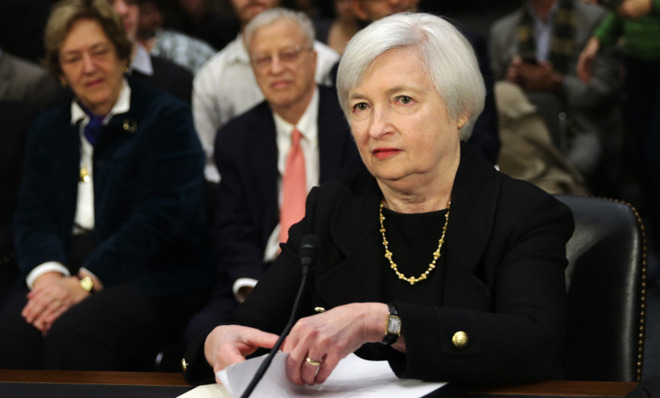What the Federal Reserve could learn from Strike Debt
The group's debt-forgiveness mission has had some eye-opening success

One year ago, a campaign group affiliated with Occupy Wall Street called Strike Debt announced a campaign called the Rolling Jubilee, which sought to buy up distressed debt for pennies-on-the-dollar — for the purpose of abolishing it.
Historically, a debt jubilee was a feature of ancient Jewish law, under which all debts were written off every seven years. So why is Strike Debt trying to do something similar?
Strike Debt describes the program as a "bailout of the people, by the people." The group targeted people struggling to service necessary debt, such as those without medical insurance who ended up needing expensive medical care.
The Week
Escape your echo chamber. Get the facts behind the news, plus analysis from multiple perspectives.

Sign up for The Week's Free Newsletters
From our morning news briefing to a weekly Good News Newsletter, get the best of The Week delivered directly to your inbox.
From our morning news briefing to a weekly Good News Newsletter, get the best of The Week delivered directly to your inbox.
So far, the Rolling Jubilee campaign has bought up and written off almost $14 million in debt. Overcoming a fair amount of skepticism, the group was able to retire all that debt using only $400,000 in funds, since creditors were eager to get any return on their investment. Here's The Guardian:
The group is able to buy debt so cheaply due to the nature of the "secondary debt market." If individuals consistently fail to pay bills from credit cards, loans, or medical insurance the bank or lender that issued the funds will eventually cut its losses by selling that debt to a third party. These sales occur for a fraction of the debt’s true values — typically for five cents on the dollar — and debt-buying companies then attempt to recoup the debt from the individual debtor and thus make a profit. [The Guardian]
By buying the debt and forgiving it, Strike Debt spared debtors the trouble of having to repay it. This is obviously a great relief to the debtor, but also helpful to the creditor, who otherwise risked losing the entire investment.
It is also beneficial to the wider economy. If debtors are relieved of their debt, then all else being equal their spending power rises. More spending means more income for other businesses. If more businesses are making more profit then they can hire more employees, reducing the unemployment rate. Newly employed people can use their income to reduce their own debt burdens, and to increase their spending. So this kind of initiative — even beginning at a small scale — can be seen as an attempt to start a virtuous cycle of debt relief: More spending and more optimism.
Buying up distressed debt and extinguishing it also takes risky assets out of the economy. Debt-based assets are an integral part of the global financial system. They are owned by lots of financial corporations like pension funds and mutual funds. This means people are counting on future income streams for things like their own retirement or their children's education. If the debtor cannot pay the debt and defaults, then the asset-owner loses out.
A free daily email with the biggest news stories of the day – and the best features from TheWeek.com
When this begins to happen en masse, perhaps due to the cumulative effects of individuals and businesses taking on too much debt and not being able to afford the repayments, market participants may begin selling. If defaults continue to rise, this can lead to more selling and lower prices, ultimately putting the entire market into panic-stricken selling mode, as occurred in 2008.
Such high loads of private and business debt can be built up over long years of prosperity. During a boom, market participants can become complacent, and lending standards can become lax under assumptions that the good years will roll on. When growth in debt exceeds growth in income for a period of time, repayment costs will begin to severely eat into income, thus decreasing spending and sparking a recession. Growth in debt severely outpaced growth in income prior to the 2007-09 recession:
Even after the bust, with debt levels still high the market may be in for more painful years of low growth and periodic recessions. As Japan's experience since the 1990s shows, deleveraging can be a long slow grind, and breaking out of expectations of low growth and deflation can be very difficult.
Strike Debt forgave a miniscule amount of debt compared with the total level of debt in the economy. That figure — including credit card debt, mortgage debt, tuition loans, government debt, interbank debt, everything — is over $57 trillion. This means the campaign has in one year written off just over 0.00002 percent of the debt in the American economy.
But what Strike Debt did accomplish is two-fold: Raising awareness of the potential benefits of debt relief, and showing how it can be done in a sustainable way. While campaigns like the Rolling Jubilee may only have limited power to relieve debt, central banks have firepower limited only by the level of inflation, which is currently very low.
The Federal Reserve's quantitative easing program is currently buying $85 billion of debt a month in the form of Treasury bonds and mortgage-backed securities, with the intention of selling them later. If Janet Yellen, who is widely expected to win Senate confirmation to lead the Federal Reserve, really wants to start significantly reducing the rate of unemployment and improving market sentiment she might want to consider buying up distressed debts and forgiving them outright.
John Aziz is the economics and business correspondent at TheWeek.com. He is also an associate editor at Pieria.co.uk. Previously his work has appeared on Business Insider, Zero Hedge, and Noahpinion.
-
 The MAGA civil war takes center stage at the Turning Point USA conference
The MAGA civil war takes center stage at the Turning Point USA conferenceIN THE SPOTLIGHT ‘Americafest 2025′ was a who’s who of right-wing heavyweights eager to settle scores and lay claim to the future of MAGA
-
 The 8 best drama movies of 2025
The 8 best drama movies of 2025the week recommends Nuclear war, dictatorship and the summer of 2020 highlight the most important and memorable films of 2025
-
 Why, really, is Trump going after Venezuela?
Why, really, is Trump going after Venezuela?Talking Points It might be oil, rare minerals or Putin